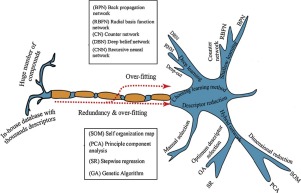Drug Discovery Today ( IF 6.5 ) Pub Date : 2018-06-21 , DOI: 10.1016/j.drudis.2018.06.016 Fahimeh Ghasemi , Alireza Mehridehnavi , Alfonso Pérez-Garrido , Horacio Pérez-Sánchez

|
The past two decades are regarded as the golden age of using neural networks (NNs) in chemoinformatics. However, two major issues have arisen concerning their use: redundancy problems when dealing with small data sets, and the large number of compounds with thousands of descriptors, which gives rise to serious overfitting problems. Various NN algorithms, based on feature selection methods and learning algorithms, were devised to avoid these predicaments in drug discovery. Pruning the overfitting problem has emerged as another challenge in recent years, leading to the advent of deep-learning (DL) networks using innovative techniques. Here, we discuss the advantages and disadvantages of the proposed NN algorithms, especially the innovative DL techniques used in ligand-based virtual screening (VS).
中文翻译:

QSAR研究中使用的神经网络和深度学习算法:优缺点
过去的二十年被视为在化学信息学中使用神经网络(NN)的黄金时代。但是,关于它们的使用,出现了两个主要问题:处理小数据集时的冗余问题,以及具有数千个描述符的大量化合物,这引起了严重的过拟合问题。基于特征选择方法和学习算法,设计了各种NN算法来避免药物发现中的这些困境。修剪过度拟合问题已成为近年来的另一项挑战,导致使用创新技术的深度学习(DL)网络的出现。在这里,我们讨论了所提出的NN算法的优缺点,尤其是在基于配体的虚拟筛选(VS)中使用的创新DL技术。











































 京公网安备 11010802027423号
京公网安备 11010802027423号